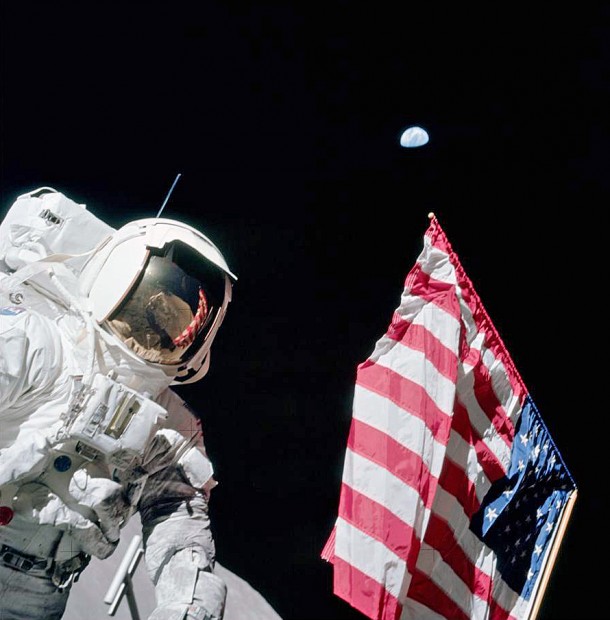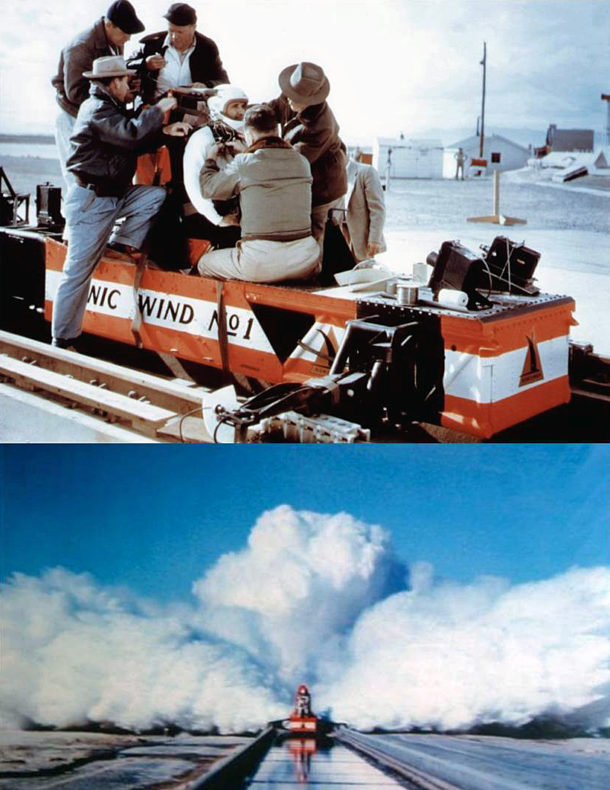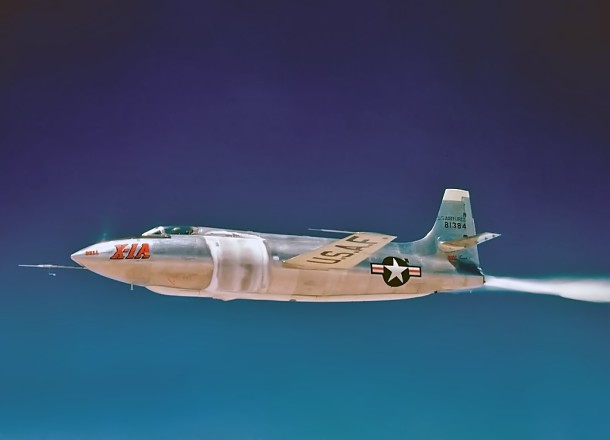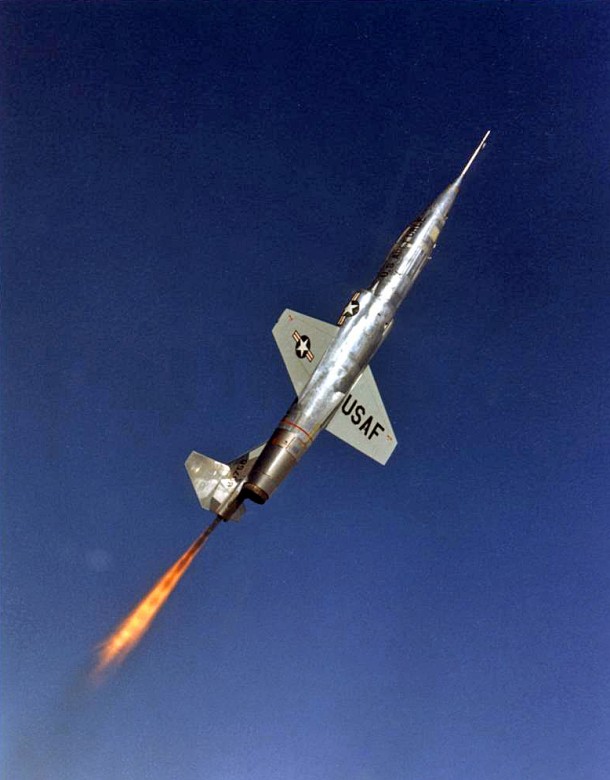
Forty-four years ago this month, NASA successfully conducted the sixth lunar landing mission of the Apollo Program. Known as Apollo 17, the flight marked the last time that men from the planet Earth explored the surface of the Moon.
Apollo 17 was launched from LC-39A at Cape Canaveral, Florida on Thursday, 07 December 1972. With a lift-off time of 05:33:00 UTC, Apollo 17 was the only night launch of the Apollo Program. Those who witnessed the event say that night turned into day as the incandescent exhaust plumes of the Saturn V’s quintet of F-1 engines lit up the sky around the Cape.
The target for Apollo 17 was the Taurus-Littrow valley in the lunar highlands. Located on the southeastern edge of Mare Serenitatis, the landing site was of particular interest to lunar scientists because of the unique geologic features and volcanic materials resident within the valley. Planned stay time on the lunar surface was three days.
The Apollo 17 crew consisted of Commander Eugene A. Cernan, Command Module Pilot (CMP) Ronald E. Evans and Lunar Module Pilot (LMP) Harrison H. Schmitt. While this was Cernan’s third space mission, both Evans and Schmitt were space rookies. Astronaut Schmitt was a professional geologist and the only true scientist to explore the surface of the Moon.
With Evans circling the Moon solo in the Command Module America, Cernan and Schmitt successfully landed their Lunar Module Challenger at 19:54:57 UTC on Monday, 11 December 1972. Their lunar stay lasted more than three days. The astronauts used the Lunar Rover for transport over the lunar surface as they conducted a trio of exploratory excursions that totaled more than 22 hours.
Cernan and Schmitt collected nearly 244 pounds of lunar geologic materials while exploring Taurus-Littrow. As on previous missions, the Apollo 17 crew deployed a sophisticated set of scientific instruments used to investigate the lunar surface environment. Indeed, the Apollo Lunar Surface Experiments Package (ALSEP) deployed during during lunar landing missions measured and transmitted vital lunar environmental data back to Earth through September 1977 when the data acquisition effort was officially terminated.
The Apollo 17 landing party departed the Moon at 22:54:37 UTC on Thursday, 14 December 1972. In a little over two hours, Challenger and America were docked. Following crew and cargo transfer to America, Challenger was later intentionally deorbited and impacted the lunar surface. The Apollo 17 crew then remained in lunar orbit for almost two more days to make additional measurements of the lunar environment.
At 23:35:09 UTC on Saturday, 16 December 1972, Apollo 17 blasted out of lunar orbit and headed home. Later, CMP Ron Evans performed a trans-Earth spacewalk to retrieve film from Apollo 17 ’s SIM Bay camera. Evans’ brave spacewalk occurred on Sunday, 17 December 1972 (69th anniversary of the Wright Brothers first powered flight) and lasted 65 minutes and 44 seconds.
Apollo 17 splashdown occurred near America Samoa in the Pacific Ocean at 19:24:59 UTC on Tuesday, 19 December 1972. America and her crew were subsequently recovered by the USS Ticonderoga.
Apollo 17 set a number of spaceflight records including: longest manned lunar landing flight (301 hours, 51 minutes, 59 seconds); longest lunar stay time (74 hours, 59 minutes, 40 seconds); total lunar surface extravehicular activity time (22 hours, 3 minutes, 57 seconds); largest lunar sample return (243.7 pounds), and longest time in lunar orbit (147 hours, 43 minutes, 37 seconds).
Apollo 17 successfully concluded America’s Apollo Lunar Landing Program. Of a sudden it seemed, America’s — and the world’s — greatest adventure was over. However, the anticipation was that the United States would return in the not-too-distant future. Indeed, Gene Cernan, the last man to walk on the Moon, spoke the following words from the surface:
“As I take man’s last step from the surface, back home for some time to come — but we believe not too long into the future — I’d like to just [say] what I believe history will record — that America’s challenge of today has forged man’s destiny of tomorrow. And, as we leave the Moon at Taurus-Littrow, we leave as we came and, God willing, as we shall return, with peace and hope for all mankind. Godspeed the crew of Apollo 17.”
It has now been 44 years since the Commander of Apollo 17 spoke those stirring words from the valley of Taurus-Littrow. Gene Cernan and most space experts of his day figured we would surely be back by now. Certainly in the 20th century. Yet, there has been no return. Moreover, there is no formal plan or funded program in the 21st century to do so. Hence, the historical record continues to list the name of Eugene A. Cernan as the last man to walk on the surface of the Moon.

Sixty-two years ago this month, USAF Lieutenant Colonel John Paul Stapp set a record for human G-tolerance when his Sonic Wind #1 rocket-powered test sled decelerated from 632 mph to a full stop in roughly 1.4 seconds. In so doing, Stapp endured a deceleration load equal to 46.2 times the weight of his body.
The period immediately following World War II marked the beginning of a steady rise in the speed and altitude capabilities of military aircraft. These performance increases subjected aircrew to wider ranges of flight loads and physical stresses. Manifold aeromedical issues and crew safety concerns arose; particularly in the area of emergency escape from a stricken aircraft.
Abandoning an aircraft in flight under emergency conditions and surviving the experience has always been a sporty proposition. Ejection forces, wind blast, body limb flailing, parachute opening shock levels, and the like make it so. Add to this list the effects of atmospheric temperature, pressure and oxygen concentration, and one starts to get an appreciation for the severity of the situation.
John Paul Stapp was a USAF physician who had an abiding interest in the aeromedical aspects of emergency escape. He knew that too many pilots were dying in situations that could have been survivable if proper equipment and procedures were available. Stapp dedicated himself to improving the chances of aircrew survival.
Stapp was a pioneer in scientifically investigating the effects of acceleration and deceleration on the human body. In March of 1947, he began a series of deceleration tests using a 2,000-foot sled track at Edwards Air Force Base. A rocket-powered test sled named the Gee Whiz carried test subjects down the track and brought them to a sudden halt to produce specific deceleration levels.
Initially, Stapp’s test subjects were anthropomorphic dummies and primates. However, he had always held to the belief that the best test subject would be a human. Better yet, a human who possessed extensive medical knowledge. Stapp selected himself for the assignment.
Stapp took his first ride down the Edwards sled test track on Wednesday, 10 December 1947. By May of 1948, he had riden the Gee Whiz a total of 16 times. One run resulted in a deceleration of 35-G’s. This meant that Stapp briefly experienced a force equal to 35 times his normal body weight during deceleration. In so doing, he pointedly dispelled the prevailing notion that a human being could not survive a deceleration level beyond 18-G’s.
Riding the sled was a form of physical abuse. Among numerous injuries, Stapp received several concussions, broke the same wrist twice, cracked ribs, and sustained retinal hemorrhages for his time on the track. All in an effort to find ways to preserve the lives of aircrew. Stapp, other human volunteers and chimpanzees continued sled testing on the Edwards track until 1953.
Stapp transferred to the Aeromedical Field Lab at Holloman Air Force Base, New Mexico in early 1953. He now had a longer track (3,550 feet) and a faster sled (Sonic Wind #1) with which to expand his deceleration research. The system was checked-out using a new crash test dummy and then a live primate. Stapp made the first human run on the Holloman track.
John Paul Stapp completed his 29th and final experimental sled test run on Friday, 10 December 1954. Propelled by a set of 9 rocket motors producing 70,000 pounds of thrust, the Sonic Wind #1 hit a peak velocity of 632 mph (Mach 0.9 at the test site altitude). Stapp endured a maximum acceleration of 20 G’s and then an incredible peak deceleration of 46.2-G’s during 1.4 seconds of slow-down. At that moment, he weighed 6,800 pounds.
Stapp took a severe pounding during his record ride. There were the “usual” body bruises, lacerations and harness burns. However, the worse effects involved his eyes. Both hemorrhaged and were completely filled with blood. Stapp indicated that all he could see was a watery salmon-colored fluid. Happily, his vision would return to quasi-normal by the next day. Stapp sported a pair of world-class shiners as peculiar momentos of his extreme deceleration experience.
Characteristically, Stapp had plans to go faster and endure more G’s. Indeed, the proposed Sonic Wind #2 test sled would be capable of driving him in excess of 1,000 mph and decelerating at more than 80 G’s. Such was not to occur as USAF would not allow Stapp to risk all again as a sled test subject.
John Paul Stapp’s legendary work produced enormous dividends in helping develop equipment, techniques and procedures that have saved the lives of countless aircrew. But the benefits of his research have gone well beyond that. Today, automobile safety standards are based in large measure on Stapp’s pioneering deceleration work. His legacy continues in other ways as well. Indeed, the 54th Stapp Car Crash Conference was held in November of this year.
John Paul Stapp, USAF officer, physician, sled test subject, was a man of uncommon valor and a bonifide hero in the truest sense of that over-used word. He willingly risked his life numerous times so that others might live. A man can do no more than that for his friends. On Wednesday, 13 November 1999, this man among men passed away peacefully in his sleep at age 89.

Sixty-three years ago today, USAF Major Charles E. Yeager set an unofficial world speed record of 1,650 mph (Mach 2.44) in the Bell X-1A flight research aircraft. In the process, the legendary test pilot very nearly lost his life when the aircraft departed controlled flight shortly after rocket motor burnout.
The USAF/Bell X-1A was a second generation X-aircraft intended to explore flight beyond Mach 2. It measured 35.5 feet in length and had a wing span of 28 feet. Gross take-off weight was 16,500 pounds.
Like its XS-1 forebear, the X-1A was powered by an XLR-11 rocket motor which produced a maximum sea level thrust of 6,000 lbs. The XLR-11 burned 9,200 pounds of propellants (alcohol and liquid oxygen) in roughly 270 seconds of operation.
Departing Edwards Air Force Base, California on Saturday, 12 December 1953, Yeager and the X-1A (S/N 48-1384) were carried to altitude by a USAF B-29 mothership (S/N 45-21800 ). X-1A drop occurred at 240 knots and 30,500 feet. Within ten seconds, Yeager lit off three of the XLR-11’s four rocket chambers and started to climb upstairs.
Yeager fired the 4th chamber of the XLR-11 passing through 43,000 feet and initiated a pushover at 62,000 feet. The maneuver was completed at 76,000 feet; higher than planned. In level flight now and traveling at Mach 1.9, the X-1A continued to accelerate in the thin air of the stratosphere.
Yeager quickly exceeded Scott Crossfield’s briefly-held Mach 2.005 record set on Friday, 20 November 1953. However, he now had to be very careful. Wind tunnel testing had revealed that the X-1A would be neutrally stable in the directional channel as it approached Mach 2.3.
As Yeager cut the throttle around Mach 2.44, the X-1A started an uncommanded roll to the left. Yeager quickly countered with aileron and rudder. The X-1A then rapidly rolled right. Full aileron and opposite rudder failed to control the roll. After 8 to 10 complete revolutions, the aircraft ceased rolling, but was now inverted.
In an instant, the X-1A started rolling left and then went divergent in all three axes. The aircraft tumbled and gyrated through the sky. Control inputs had no effect. Yeager was in serious trouble. He could not control his aircraft and punching-out was not an option. The X-1A had no ejection seat.
Chuck Yeager took a tremendous physical and emotional beating for more than 70 seconds as the X-1A wildly tumbled. Normal acceleration varied between plus-8 and negative 1.3 G’s. His helmet hit the canopy and cracked it. He struck the control column so hard that it was physically bent. His frantic air-to-ground communications were distinctly those of a man who was convinced that he was about to die.
As the X-1A tumbled, it decelerated and lost altitude. At 33,000 feet, a battered and groggy Yeager found himself in an inverted spin. The aircraft suddenly fell into a normal spin from which Yeager recovered at 25,000 feet over the Tehachapi Mountains situated northwest of Edwards. Somehow, Yeager managed to get himself and the X-1A back home intact.
The culprit in Yeager’s wide ride was the then little-known phenomenon identified as roll inertial coupling. That is, inertial moments produced by gyroscopic and centripetal accelerations overwhelmed aerodynamic control moments and thus caused the aircraft to depart controlled flight. Roll rate was the critical mechanism since it coupled pitch and yaw motion.
The X-1A held the distiction of being the fastest-flying of the early X-aircraft until the Bell X-2 reached 1,900 mph (Mach 2.87) in July of 1956. Yeager’s harrowing experience in December 1953 would be his last flight at the controls of a rocket-powered X-aircraft. For his record-setting X-1A mission, Chuck Yeager was awarded the 1953 Harmon Trophy.

Fifty-three years ago today, USAF Major Robert W. Smith zoomed the rocket-powered Lockheed NF-104A to an unofficial world record altitude of 120,800 feet. This mark still stands as the highest altitude ever achieved by a United States aircraft from a runway take-off.
A zoom maneuver is one in which aircraft kinetic energy (speed) is traded for potential energy (altitude). In doing so, an aircraft can soar well beyond its maximum steady, level altitude (service ceiling). The zoom maneuver has both military and civilian flight operations value.
The USAF/Lockheed NF-104A was designed to provide spaceflight-like training experience for test pilots attending the Aerospace Research Pilot School (ARPS) at Edwards Air Force Base, California. The type was a modification of the basic F-104A Starfighter aircraft. Three copies of the NF-104A were produced (S/N’s 56-0756, 56-0760 and 56-0762). It was the ultimate zoom flight platform.
In addition to a stock General Electric J79-GE-3 turbojet, the NF-104A was powered by a Rocketdyne LR121-NA-1 rocket motor. The J79 generated 15,000 pounds of thrust in afterburner and burned JP-4. The LR-121 produced 6,000 pounds of thrust and burned a combination of JP-4 and 90% hydrogen peroxide. Rocket motor burn time was on the order of 90 seconds.
The NF-104A was kinematically capable of zooming to altitudes approaching 125,000 feet. As such, it was a combined aircraft and spacecraft. The pilot had to blend aerodynamic and reaction controls in the low dynamic pressure environment near the zoom apex. He was also required to fly in a full pressure suit for survival at altitudes beyond the Armstrong Line.
On Friday, 06 December 1963, Bob Smith took-off from Edwards and headed west for the Pacific Ocean. Out over the sea, he changed heading by 180 degrees in preparation for the zoom run-in. At a point roughly 100 miles out, Smith then accelerated the NF-104A (S/N 56-0760) along a line that would take him just north of the base. Arriving at Mach 2.4 and 37,000 feet, Smith then initiated a 3.75-g pull to a 70-degree aircraft pitch angle. Turbojet and rocket were at full throttle.
Things happened very quickly now. Smith brought the turbojet out of afterburner at 65,000 feet and then moved the throttle to the idle detent at 80,000 feet. The rocket motor burned-out around 90,000 feet. Smith controlled the aircraft (now spacecraft) over the top of the zoom using 3-axis reaction controls. The NF-104A’s arcing parabolic trajectory subjected him to 73 seconds of weightlessness. Peak altitude achieved was 120,800 feet above mean sea level.
On the back side of the zoom profile, Bob Smith restarted the windmilling J79 turbojet and set-up for landing at Edwards. He touched down on the main runway and rolled out uneventfully. Total mission time from brake-release to wheels-stop was approximately 25 minutes.
Much more could be said about the NF-104A and its unique mission. Suffice it to say here that two of the aircraft ultimately went on to serve in the ARPS from 1968 to 1971. The only remaining aircraft today is 56-0760 which sits on a pole in front of the USAF Test Pilot School (TPS) at Edwards.
Bob Smith went on to make many other noteworthy contributions to aviation and his nation. Having flown the F-86 Sabre in Korea, he volunteered to fly combat in Viet Nam in his 40th year. Stationed at Korat AFB in Thailand, he commanded the 34th Fighter Squadron of the 388th Tactical Fighter Wing. Smith flew 100 combat missions in the fabled F-105D Thunderchief; many of which involved the infamous Pack VI route in North Viet Nam.
Bob Smith was a true American hero. Like so many of the airmen of his day, Smith was a man whose dedication, service, and courage went largely unnoticed and unappreciated by his fellow countrymen. Bob Smith’s final flight came just 3 months shy of his 82nd birthday on Thursday, 19 August 2010.




